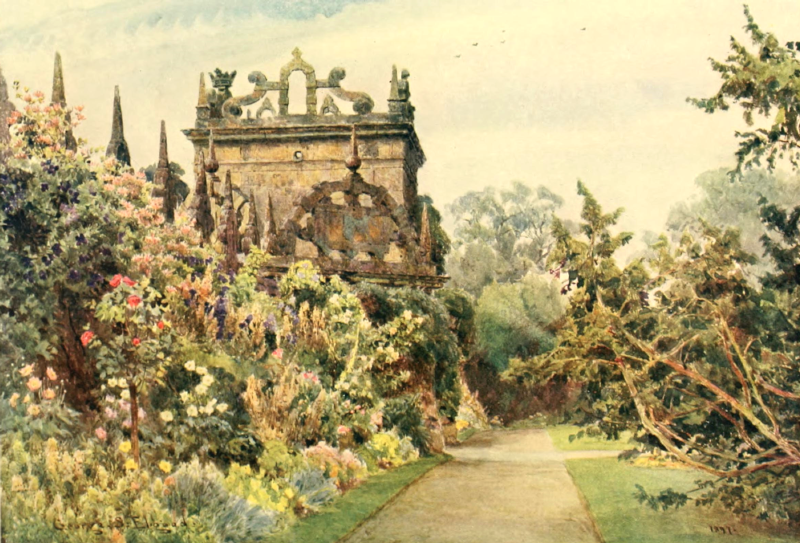| Web
and Book design,
Copyright, Kellscraft Studio 1999-2021 (Return to Web Text-ures) |
 (HOME)
|
|
HARDWICK Hardwick
Hall in Derbyshire, one of the great houses of England, is, with others of its
approximate contemporaries of the later half of the sixteenth century, such as
Longleat, Wollaton, and Montacute, an example of what was at the time of its erection
an entirely new aspect of the possibilities of domestic architecture. The
country had settled down into a peaceful state. A house was no longer a castle
needing external defence. Hitherto the homes of England had been either
fortresses, or had needed the protection of moats and walls. They had been
poorly lighted; only the walls looking to an inner court, or to a small walled
garden could have fair-sized openings. No spacious windows could look abroad
upon open country, field or woodland. But by this time such restriction was a
thing of the past, and we see in these great houses, and in Hardwick
especially, immense window spaces in the outer walls. The architects of the
time, John Thorpe, the Smithsons and others, ran riot with their great windows,
as if revelling in their exemption from the older bonds. The new freedom was so
tempting that they knew not how to restrain themselves, and it was only later,
when it was found that the amount of lighting was overmuch for convenience,
that the relation of degree of light to internal comfort came to be better
understood and more reasonably adjusted. The
famous Countess of Shrewsbury (Bess of Hardwick), to whose initiative this
great house owes its origin, set an imperishable memorial of her imperious
arrogance upon the balustrading that crowns the square tower-like projections
at the angles and ends of the building, where the stone is wrought into lace-like fretwork of
arabesque, whereof the chief features are her coronet and the initials of her
name. A
spacious forecourt occupies the ground upon the western — the main entrance
front. It stretches the whole length of the house, and projects as much forward;
its outer sides being inclosed with a wall that bears in constant succession an
ornament of a fleur-de-lys with tall pyramidal top, a detail imported direct
from Italy, from the Renaissance gardens of earlier date. Such an ornament
occurs at the Villa d'Este at Tivoli, crowning a retaining wall. The entrance
to the inclosed forecourt is by a handsome stone gateway. This gateway forms
the background of the picture, which shows one of the well-planted flower
borders that abound at Hardwick, and that strike that lightsome and cheerful
note of human care and delight that is so welcome in this place whose scale is rather
too large, and somewhat coldly forbidding, in relation to the more ordinary
aspects of daily comfort. Indeed
— for all the good planting — the long wall-backed flower border facing south,
whose wall is in part of its length that or the house itself, looks as if, in
relation to the great building towering above it — its occupants were still too
small, although they include flowering plants seven to nine feet high, such as
Gyneriums and the larger herbaceous Spiraeas. A well-directed effort has
evidently been made to have the planting on a scale with the lordly building,
but the items want to be larger still and the grouping yet bolder, to overcome
the dwarfing effect of the towering structure. In such a place the Magnolias,
both evergreen and deciduous, would have a fine effect, though possibly they
would hardly thrive in the midland climate. Within
the forecourt, along the wall parallel to the house and furthest from it, this need
is not so apparent. In the subject of the picture, the Honeysuckle, the
magnificently grown purple Clematis upon the wall, the Mulleins, Bocconia and
Japan Anemones, are in due proportion; the Tufted Pansies and Mignonette
bringing their taller brethren happily down to the grassy verge. Approaching
the pathway from the right, stretch 
THE FORECOURT: HARDWICK From the picture in the possession of Mr. Aston Webb some
of the long loose growths of one of the two large Cedars that are such
prominent objects in the forecourt garden. The
main open spaces of this garden repeat in flower beds on grass the big E.S. of
the self-asserting founder. It is not pretty gardening nor particularly
dignified. No doubt it is only a modern acquiescence in the dominating
tradition of the place. Even making allowance for, and retaining this
sentiment, a better design might have been made, embodying these already
too-often-repeated letters. Moreover, the servile copying of the lettering in
its stone form only serves to illustrate the futility of reproducing a form of
ornament designed for one material in another of totally different nature. There
is some excellent gardening in a long flower-border outside the forecourt wall.
Here the size of the house is no longer oppressive, and it comes into proper
scale a little way beyond the point where the broad green ways, bounded by
noble hedges of ancient yews, swing into a wide circle as they cross, and show
the bold niches cut in the rich green foliage where leaden statues are so
effectively placed. By
the kindness of the owner, the Duke of Devonshire, Hardwick Hall, illustrating
as it does a distinct form of architectural expression with much of historical
interest, is open to the public. |